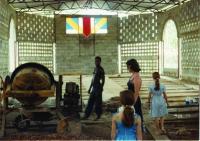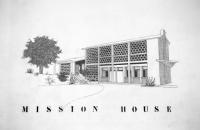Build something modern
Published in 20th-century / Contemporary History, Issue 4 (July/August 2011), Reviews, Volume 19
The interior of a church under construction at Port Harcourt, Nigeria, in 1977. (St Patrick’s Missionary Society, Kiltegan)
In the first wave of independence during the late 1950s and early 1960s, most sub-Saharan African states were expected to follow the modernising road, both by the departing colonial administrators and by the incoming African rulers. Africans would build legal-rational states underpinned by a newly emerging African nationalism. Modernity offered sub-Saharan Africa the chance to enter history. The fixed and immutable hierarchies or the lack of any state structures that had been commented on by thinkers as distant in time as Hegel in the early nineteenth century and Hugh Trevor Roper in the 1960s would be done away with as new, meritocratic states took their place on the world stage.
The shallowness of that vision quickly became apparent. Within a relatively short time, many of the leaders at independence had been replaced: one-party states and military dictatorships became the norm, and images of civil war, most notably in Biafra, began to characterise popular western perceptions of Africa. Some states, if they didn’t prosper, nonetheless seemed to be achieving some of their initial goals: Kenya maintained good growth figures well into the 1970s; Tanzania was making headway in the provision of basic needs in the areas of health and education; Zambia seemed to prosper as long as copper prices held up.
The relevance of modernity, however, with its assured trajectories, began to be debated. Perhaps modernity was an exclusively European phenomenon that could not be exported. Perhaps there was a specifically African modernity that had its own characteristics independent of western modelling. A case can be made for a West African form of modernity. In a region where the economic motor was rural production, innovation was led by African farmers who introduced cocoa through the dissemination of saplings and of expertise. Other recognisably modern elements in the economy—printing, bottling, transport, baking and recording—were pioneered by Africans. Elsewhere, in East and Southern Africa, the case for a pre-colonial modernity was much more difficult to argue: a Eurocentric concept deployed to valorise the difference between metropolis and periphery rather than a term with any analytical specificity or meaning.

A drawing of a Nigerian mission house by Pearse McKenna, who pioneered the way for Irish architects in Africa. (Pearse McKenna)
Yet, for many Africans, modernity could acquire its own meaning: not a matter of past and present but of up and down. The aspiration to modernity is the aspiration to improve one’s lot, to rise in the world economically and politically, to aspire to the things that many westerners take for granted, to aspire to equality on the world stage, and even more particularly to aspire to improvements in health, education and water supply, to achieve what was once known as progress. The abandonment of modernity amounts to the abandonment of hope, the consignment of much of the continent to a permanent wretchedness from which there is no escape. At some level, modernity has acquired its own African meaning.
The most visible representation of modernity is architecture. New ministry buildings across Africa—of science and technology, education, power generation—were designed to impress on ordinary citizens the sheer scale of the technocratic change that was taking place. The few African architectural students I have known have aspired to build modern buildings, to master the technologies and concepts that inform building at its most advanced; that these buildings may or may not be best suited to the tropics is neither here nor there.
In the 1950s and 1960s a number of young Irish architects went to Africa to build the modern buildings they were unable to construct at home. They, and their missionary contemporaries, are the subjects of Build something modern, a film that uses contemporary interviews cut with archival film to tell their story. Seán Rothery, who went to Kampala in the 1950s, describes himself at the time as ‘a mainline, card-carrying modernist’. The great influence was le Corbusier, the beacon of a universal modernism, the builder of Chandigarh in India that so symbolised the change the Congress Party there aspired to.
But many Irish architects were engaged in building Catholic churches, and in one case a cathedral, as well as schools. Christian missionary activity in Africa has come to be seen in an ambiguous light: the urge to convert suggests a profound rejection of African value systems as having no worth, but the provision of health services and education suggests an ethos of care; and, for some Africans, the move to an alternative belief system allowed a way out of traditional structures that had very fixed and limiting roles for members. Build something modern tells the story of the interaction of architect and missionary in slow, ruminative terms: the atmosphere of the places where these people lived and worked is built up through layers of film, graphics and sound, with constant reference to climate and the determining role of the sun in considerations of how and where to build. Pearse McKenna, who, along with Seán Rothery and others, would work on the rebuilding of St Michael’s Church in Dún Laoghaire after a fire in 1968, pioneered the way for Irish architects in Africa. Confusion of meaning between an Irish architect and African builders was inevitable, if humorous. On one church in Nigeria McKenna had included on the drawings shadow lines at a 45º angle: on going to inspect the building, he found that these had been painted on to the church façade.

Director Paul Rowley with Solomon Osha, who narrated the film’s voice-over. (Still Films)
On returning to Uganda years later, Seán Rothery found that most of the buildings he had worked on no longer existed; a succession of wars and an expanding city had obliterated an earlier time. Elsewhere, churches of the period represent a certain calibration in African history, the major public, modern, independent popular aesthetic that most people encounter. The challenge of building a cathedral must be irresistible to any architect, as Richard Hurley testifies, but it seems to have brought little recognition. Most of the architects of the period returned to Ireland to work. Most of the missionaries stayed on. They are now old, living out their retirement in Ireland, but they have a toughness about them that suggests that the primary problems they faced in Africa were practical. The mechanics of building were part of the mechanics of survival; in the end it was the ethos of care that predominated. Build something modern focuses on a time when the divide between the religious and the secular was far less pronounced than now; a time when, arguably, at one level, Ireland and Africa were much closer in outlook. HI
Eoin Dillon is a scholar of twentieth-century African history.
















